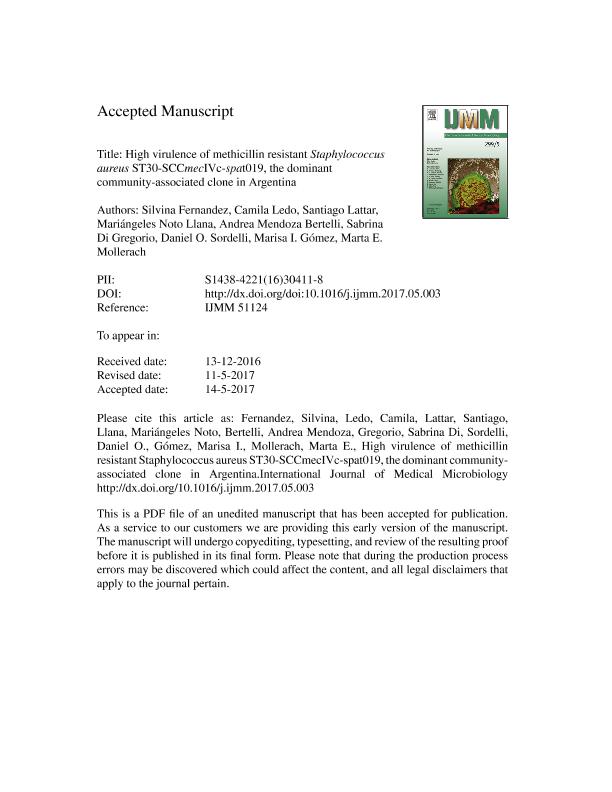Artículo
High virulence of methicillin resistant Staphylococcus aureus ST30-SCC mec IVc- spa t019, the dominant community-associated clone in Argentina
Fernández, Silvina; Ledo, Camila ; Lattar, Santiago Martín
; Lattar, Santiago Martín ; Noto Llana, Mariangeles
; Noto Llana, Mariangeles ; Mendoza Bertelli, Andrea Cristina
; Mendoza Bertelli, Andrea Cristina ; Di Gregorio, Sabrina Noelia
; Di Gregorio, Sabrina Noelia ; Sordelli, Daniel Oscar
; Sordelli, Daniel Oscar ; Gomez, Marisa Ines
; Gomez, Marisa Ines ; Mollerach, Marta Eugenia
; Mollerach, Marta Eugenia
 ; Lattar, Santiago Martín
; Lattar, Santiago Martín ; Noto Llana, Mariangeles
; Noto Llana, Mariangeles ; Mendoza Bertelli, Andrea Cristina
; Mendoza Bertelli, Andrea Cristina ; Di Gregorio, Sabrina Noelia
; Di Gregorio, Sabrina Noelia ; Sordelli, Daniel Oscar
; Sordelli, Daniel Oscar ; Gomez, Marisa Ines
; Gomez, Marisa Ines ; Mollerach, Marta Eugenia
; Mollerach, Marta Eugenia
Fecha de publicación:
06/2017
Editorial:
Elsevier Gmbh
Revista:
International Journal of Medical Microbiology (print)
ISSN:
1438-4221
Idioma:
Inglés
Tipo de recurso:
Artículo publicado
Clasificación temática:
Resumen
Community-acquired methicillin resistant Staphylococcus aureus emerged as a worldwide health problem in the last few years. In Argentina, it is found in 70% of skin and skin structure infections in previously healthy adult patients and causes severe invasive diseases. The ST30-SCCmecIVc-spat019 clone is predominant in adult infections and has displaced the previously prevalent ST5-SCCmecIVa-spat311 clone in community settings. In the present work we compared the virulence of both clones in order to explain the displacement, and found that ST30-IVc is associated with invasive infections in adult patients from Argentina and possesses a different virulence-associated genes profile compared to ST5-IVa. A representative strain of ST30 lineage has a more aggressive behavior in animal models of infection and expresses higher level of Fibronectin binding protein A coding gene, which could enhance the bacterial invasion capacity.
Archivos asociados
Licencia
Identificadores
Colecciones
Articulos(OCA HOUSSAY)
Articulos de OFICINA DE COORDINACION ADMINISTRATIVA HOUSSAY
Articulos de OFICINA DE COORDINACION ADMINISTRATIVA HOUSSAY
Citación
Fernández, Silvina; Ledo, Camila; Lattar, Santiago Martín; Noto Llana, Mariangeles; Mendoza Bertelli, Andrea Cristina; et al.; High virulence of methicillin resistant Staphylococcus aureus ST30-SCC mec IVc- spa t019, the dominant community-associated clone in Argentina; Elsevier Gmbh; International Journal of Medical Microbiology (print); 307; 4-5; 6-2017; 191-199
Compartir
Altmétricas



